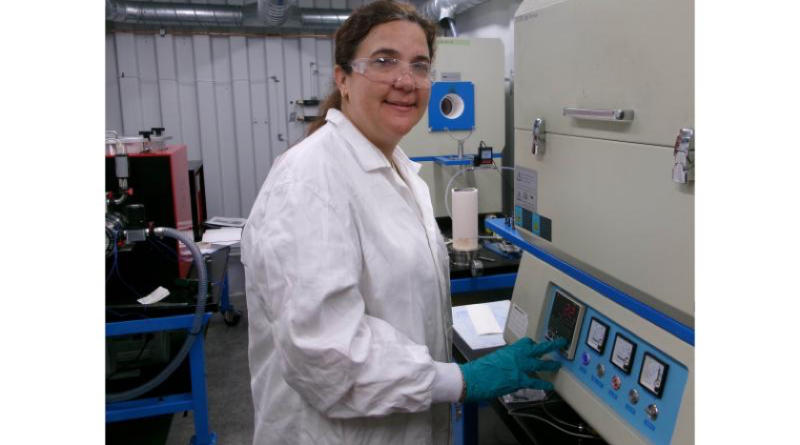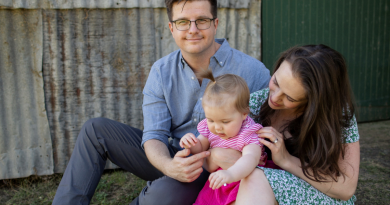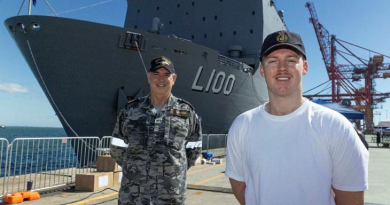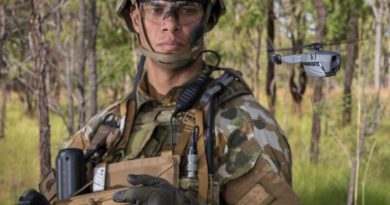Extreme science with meaning

Extreme temperatures, futuristic testing chambers, advanced equipment, Bunsen burners and flammable materials are all in a day’s work for Miriem Santander Borrego.
CAPTION: Dr Miriem Santander Borrego is a chemical science specialist working with materials in the Extreme Environment Materials & Forensics laboratory at the DST Group Eagle Farm, Brisbane. Story by Flight Lieutenant Marina Power. Photo by Scott Sarstedt-McCarthy.
Raised in Cuba and arriving in Australia in 2007, Dr Santander Borrego always had a curious mind.
“Growing up I was always interested in finding out how things worked – why do you get different colours from mixing other colours, how do you get bubbles, why do some chemicals, when combined, go ‘boom’?” Dr Santander Borrego said.
After completing her studies – culminating with a PhD in macromolecular and material science at the University of Queensland more than 10 years ago – and working as an academic, Dr Santander Borrego had a choice of industries to choose from, including medical, pharmaceutical, technology and academia. She chose Defence.
In 2016 Dr Santander Borrego started looking at different jobs that offered security and job stability as she had a baby at the time.
“With a young family, it was important for me to have career stability. I wanted to do important work but not have to work on weekends. I really needed a healthy work-life balance,” Dr Santander Borrego said.
“I was lucky. I was successful in my application for the position of analytical chemist within the Individual Protection and Hazard Management Science and Technology Centre at Defence Science and Technology Group (DSTG). After starting in the role as a contractor, I successfully applied and got a permanent position two years later,” she said.
In 2020, for personal reasons Dr Santander Borrego’s family moved from Melbourne to Brisbane. There, she joined another DSTG’s Extreme Environment Materials and Forensics team, leading the design, modelling, fabrication and experimental verification of coating for hypersonic applications as a chemical science specialist.
Last year, Dr Santander Borrego was awarded a Chief Defence Scientist Discovery fellowship for the ‘Fabrication of broadband antireflective coating for use in space’ project. This work in material science comprises the research and development of space-based optical antireflective coatings for the manufacture of more efficient solar cells, capable of surviving the harsh environment of space.
So, just what is ‘material science’? According to Dr Santander Borrego, it’s integral to the development of ‘everything’.
“For Defence purposes, it is understanding how a certain material is made, including its chemical composition, the mechanical property of the material, its stress and friction points. And then being able to re-create that material through a chemical reaction and ensuring that is a repeatable process, in order to learn from it and to improve it,” she said.
In Defence, material science has a number of applications, including hypersonic, space and quantum technology, to name a few.
After extensive research and development phases, Dr Santander Borrego also tests the materials.
“We have to ensure that the testing is done to reflect real-live temperature conditions of Earth’s low orbit, which ranges between minus 65 degrees to over 125 degrees Celsius, ensuring the material can perform as intended under those environments,” Dr Santander Borrego said.
When testing the antireflective coating, the results proved even more successful than anticipated.
Through the application of material science, Dr Santander Borrego has developed a novel antireflective coating, combining surface topography with layer deposition. Joining these two different surfaces is just like mixing the colours blue and yellow to get a green.
“The tests of the properties of the newly created reflective surface coatings were even better than I expected,” Dr Santander Borrego said.
“We created a totally new surface with many applications for Defence – not just in space, but also in hypersonic sensors and others.
“I also get to enjoy collaboration opportunities through my work with academia and industry, ensuring that I am able to stay at the top of my chosen scientific field.”
DSTG employs around 2300 staff in its various facilities located in Edinburgh (South Australia), Melbourne, Canberra, Sydney, Brisbane, HMAS Stirling (Western Australia), Scottsdale (Tasmania), and Innisfail (Queensland).
.
.

.
.





